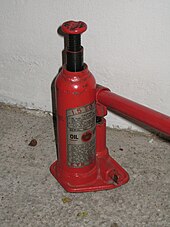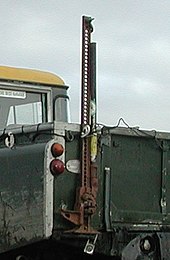
A jack is a mechanical lifting device used to apply great forces or lift heavy loads. A mechanical jack employs a screw thread for lifting heavy equipment. A hydraulic jack uses hydraulic power. The most common form is a car jack, floor jack or garage jack, which lifts vehicles so that maintenance can be performed. Jacks are usually rated for a maximum lifting capacity (for example, 1.5 tons or 3 tons). Industrial jacks can be rated for many tons of load.
Etymology
The personal name Jack, which came into English usage around the thirteenth century as a nickname form of John, came in the sixteenth century to be used as a colloquial word for 'a man (of low status)' (much as in the modern usage 'jack of all trades, master of none'). From here, the word was 'applied to things which in some way take the place of a lad or man, or save human labour'. The first attestation in the Oxford English Dictionary of jack in the sense 'a machine, usually portable, for lifting heavy weights by force acting from below' is from 1679, referring to 'an Engine used for the removing and commodious placing of great Timber.'
Jackscrew
Scissor jack

A scissor jack use the mechanical advantage of a leadscrew and 4-bar linkage to allow a human to lift a vehicle by manual force alone. They are inexpensive and are common in manufacturer-supplied breakdown kits. The jack shown at the left is made for a modern vehicle and the notch fits into a jack-up point on a unibody. Earlier versions have a platform to lift on a vehicle's frame or axle.
Electrically operated car scissor jacks are powered by 12 volt electricity supplied directly from the car's cigarette lighter receptacle. The electrical energy is used to power these car jacks to raise and lower automatically. Electric jacks require less effort from the motorist for operation.
House jack

A house jack, also called a screw jack, is a mechanical device primarily used to lift buildings from their foundations for repairs or relocation. A series of jacks is used and then wood cribbing temporarily supports the structure. This process is repeated until the desired height is reached. The house jack can be used for jacking carrying beams that have settled or for installing new structural beams. On the top of the jack is a cast iron circular pad that the jacking post rests on. This pad moves independently of the house jack so that it does not turn as the acme-threaded rod is turned with a metal rod. This piece tilts very slightly, but not enough to render the post dangerously out of plumb.
Hydraulic jack
Further information: Hydraulic machinery

In 1838 William Joseph Curtis filed a British patent for a hydraulic jack.
In 1851, inventor Richard Dudgeon was granted a patent for a "portable hydraulic press" – the hydraulic jack, a jack which proved to be vastly superior to the screw jacks in use at the time.
Hydraulic jacks are typically used for shop work, rather than as an emergency jack to be carried with the vehicle. Use of jacks not designed for a specific vehicle requires more than the usual care in selecting ground conditions, the jacking point on a vehicle, and to ensure stability when the jack is extended. Hydraulic jacks are often used to lift elevators in low and medium rise buildings.
A hydraulic jack uses a liquid, which is incompressible, that is forced into a cylinder by a pump plunger. Oil is used since it is self lubricating and stable. When the plunger pulls back, it draws oil out of the reservoir through a suction check valve into the pump chamber. When the plunger moves forward, it pushes the oil through a discharge check valve into the cylinder. The suction valve ball is within the chamber and opens with each draw of the plunger. The discharge valve ball is outside the chamber and opens when the oil is pushed into the cylinder. At this point the suction ball within the chamber is forced shut and oil pressure builds in the cylinder.
Floor jack

In a floor jack (aka 'trolley jack') a horizontal piston pushes on the short end of a bellcrank, with the long arm providing the vertical motion to a lifting pad, kept horizontal with a horizontal linkage. Floor jacks usually include casters and wheels, allowing compensation for the arc taken by the lifting pad. This mechanism provides a low profile when collapsed, for easy maneuvering underneath the vehicle, while allowing considerable extension.
Bottle jack
"Bottle jack" redirects here. For the meat-roasting device, see Roasting jack.
A bottle jack or whiskey jack is a jack which resembles a bottle in shape, having a cylindrical body and a neck. Within is a vertical lifting ram with a support pad of some kind fixed to the top. The jack may be hydraulic or work by screw action. In the hydraulic version, the hydraulic ram emerges from the body vertically by hydraulic pressure provided by a pump either on the baseplate or at a remote location via a pressure hose. With a single action piston the lift range is somewhat limited, so its use for lifting vehicles is limited to those with a relatively high clearance. For lifting structures such as houses the hydraulic interconnection of multiple vertical jacks through valves enables the even distribution of forces while enabling close control of the lift.
The screw version of the bottle jack works by turning a large nut running on the threaded vertical ram at the neck of the body. The nut has gear teeth, and is generally turned by a bevel gear spigotted to the body, the bevel gear being turned manually by a jack handle fitting into a square socket. The ram may have a second screwed ram within it, which doubles the lifting range telescopically.
Bottle jacks have a capacity of up to 50 tons and may be used to lift a variety of objects. Typical uses include the repair of automobiles and house foundations. Larger, heavy-duty models may be known as a barrel jack.
This type of jack is best used for short vertical lifts. Blocks may be used to repeat the operation when a greater amount of elevation is required.
Pneumatic jack
Air hydraulic jack
An air hydraulic jack is a hydraulic jack that is actuated by compressed air - for example, air from a compressor - instead of human work. This eliminates the need for the user to actuate the hydraulic mechanism, saving effort and potentially increasing speed. Sometimes, such jacks are also able to be operated by the normal hydraulic actuation method, thereby retaining functionality, even if a source of compressed air is not available.
Inflatable jack

An inflatable jack, lifting bag, or pneumatic lifting bag is an air bag that is inflated by compressed air (without a hydraulic component) in order to lift objects. The bag can be deflated to be reused later. The objects can be of a smaller load such as an automobile or it can be a larger object such as an airplane.
Air bags are also used by rescuers to lift heavy objects up to help victims who are trapped under those objects. There are three main types of lifting bags for rescue: high pressure, medium pressure and low pressure systems. Low-pressure bags are operated at 7.25 psi for high vertical lift in a large surface area but lower lifting capacities. Medium-pressure bags are operated at 15 psi. High-pressure bags which have higher lifting capacities are operated at pressure between 90 and 145 psi. Two air bags can be stacked together to provide a higher lift. It is recommended that no more than two bags can be used in a stacked configuration, the bigger bag must be the bottom one, and no other objects are inserted between the stacked bags. Incorrect use of stacked bags may result in a bag (or other objects) shooting out to create a dangerous projectile.
Strand jack
A strand jack is a specialized hydraulic jack that grips steel cables. Often used in concert, strand jacks can lift hundreds of tons and are used in engineering and construction.
Farm jack

The farm jack also known as a railroad jack, high lift jack, handyman jack, trail jack or kanga-jack was invented in 1905. It consists of a steel beam with a series of equally spaced holes along its length, and a hand-operated mechanism which can be moved from one end of the beam to the other through the use of a pair of climbing pins. Typical sizes for the farm jack are 4 feet (1.2 m), 5 feet (1.5 m)and 6 feet (1.8 m) referring to the length of the beam.
The jack's versatility stems from its use for such applications as lifting, winching, clamping, pulling and pushing. It is this versatility, along with the long travel it offers and its relative portability, which make the farm jack so popular with off-road drivers.
Safety standards
National and international standards have been developed to standardize the safety and performance requirements for jacks and other lifting devices. Selection of the standard is an agreement between the purchaser and the manufacturer, and has some significance in the design of the jack. In the United States, ASME has developed the Safety Standard for Portable Automotive Service Equipment, last revised in 2014, including requirements for hydraulic hand jacks, transmission jacks, emergency tire changing jacks, service jacks, fork lift jacks, and other lifting devices.
See also
References
- "Different Types of Jacks | Metro Hydraulic". www.metrohydraulic.com. Archived from the original on 2016-05-01. Retrieved 2016-02-05.
- Oxford English Dictionary Online, quoting senses II and 10a.
- "9: "In Case of Emergency"". Owner's Manual Outback (2019A ed.). Camden, New Jersey: Subaru Corporation. June 2018. pp. 9–7.
Place the jack under the side sill at the front or rear jack-up point closest to the flat tire.
- "Patents for Inventions: Abridgments of Specifications : Class". 1872.
- Dudgeon, Jl Ujb richard (Jan 25, 1859), Richard dudgeon, retrieved 2016-02-05
- William Cox (July 2001), "Light Talk on Heavy Jacks", Old-House Journal: 37
- Brian S. Elliott (2006), "Air-Over-Hydraulic Jacks", Compressed air operations manual, McGraw-Hill Professional, pp. 56–58, ISBN 978-0-07-147526-6
- George William Sutcliffe (1895), Steam power and mill work principles and modern practice, Whittaker & Co., p. 828,
The bottle-jack is exceedingly firm and safe for short vertical lifts, but is not convenient for pushing in a horizontal or oblique direction.
- John Norman (2009), Fire Department Special Operations, Fire Engineering Books, p. 51, ISBN 978-1-59370-193-2
- "Detroit Listening Post". Popular Mechanics. 132 (4): 44. October 1969. ISSN 0032-4558. Retrieved 9 June 2017.
- "Lifting Bag and Poppet Riveter Repair "Forts"". Popular Mechanics. 81 (1): 26. January 1944. ISSN 0032-4558. Retrieved 9 June 2017.
- "Pneumatic Lifting Bags". Windsor Fire & Rescue Services. Archived from the original on 28 December 2011. Retrieved 6 October 2013.
- "Safety Standard for Portable Automotive Service Equipment - ASME".